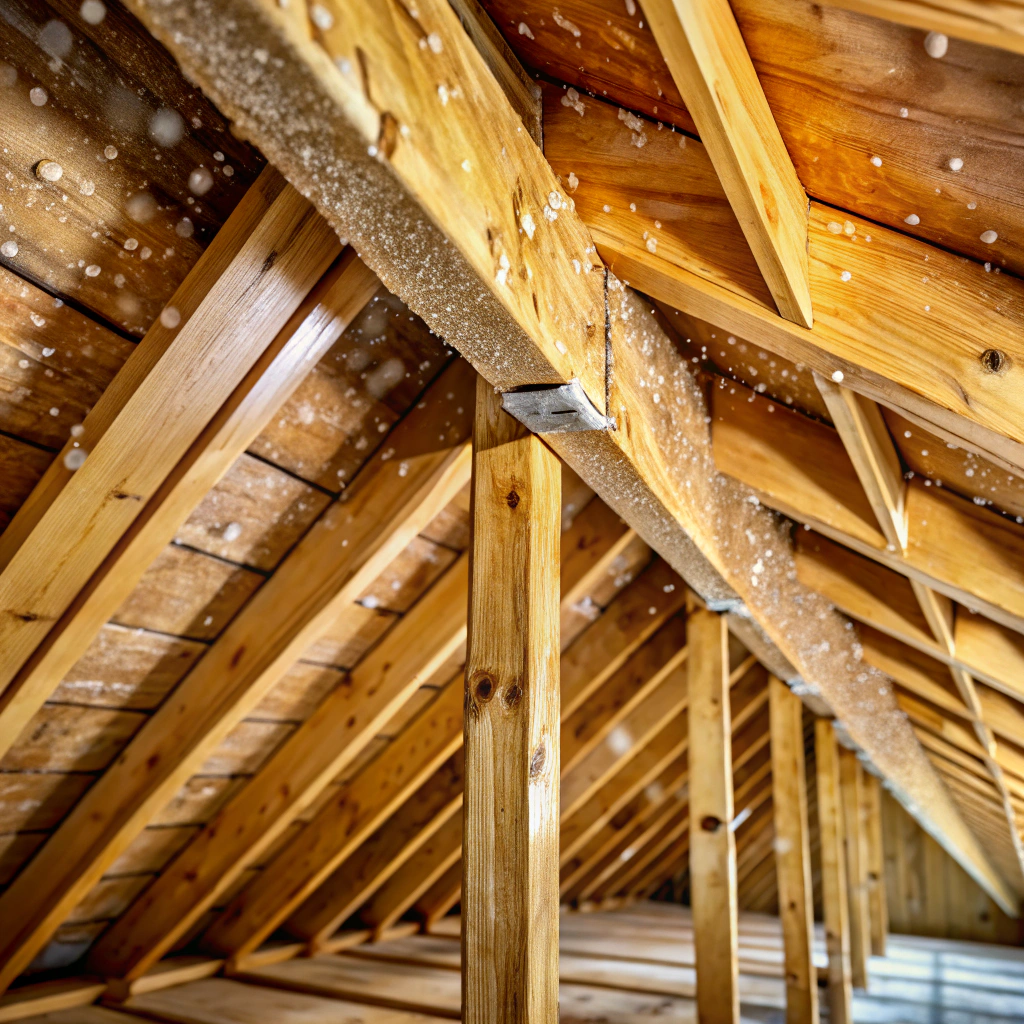Last updated on
Discover what a roof vent is and why it’s the unsung hero of attic health and energy efficiency.
Ever wondered what makes your roof breathe easier than a yogi in a meditation retreat? Roof vents! These stealthy saviors maintain your home’s serenity by balancing the air like a zen master, warding off moisture and heat disasters that could turn your attic into a tropical sauna. Dive headfirst into the world of roof vents, where we’ll unravel their types, unveil their importance, and maybe drop a joke or two as we breeze through the magic of ventilation. Breathe easy, your roof’s got this!
Key takeaways:
- Roof vents maintain attic air balance and health.
- Types include ridge, static, turbine, and solar vents.
- Proper ventilation prevents mold and moisture buildup.
- Exhaust vents expel stale air, enhancing air quality.
- Good ventilation extends roof life and reduces energy costs.
Types of Roof Vents

Time to dive into the quirky world of roof vents. They come in different shapes and personalities, sort of like people at a party. Let’s paint the town with their quirks.
First, meet the ridge vents. Like the cool folks chilling at the peak of the roof, they’re always working incognito to keep air flowing smoothly. Then there are the static vents, akin to diligent wallflowers. They stay put, silently doing their job without a fuss.
Next up, the turbine vents. They’re the life of the rooftop bash, spinning energetically with the wind like they’re auditioning for Dancing with the Stars. Solar-powered vents are the eco-friendly enthusiasts, absorbing every ray to power their ventilation prowess.
Don’t forget the soffit vents. They’re the welcoming committee, quietly inviting fresh air to the soiree and ensuring stale air knows its time’s up.
Each vent has its charm, but together they ensure your roof party doesn’t turn into a sweat fest. Keep them in sync, and your roof will thank you with a cool demeanor year-round.
Importance of Roof Ventilation
Ventilation is like a spa day for your roof. It keeps things from getting stuffy up there, extending your roof’s life expectancy and keeping energy bills happy.
Think of it as your roof’s personal trainer, preventing heat and moisture buildup. It ensures cozy winter nights by reducing ice dams. In summer, it helps combat heatwaves from turning your attic into a sauna by allowing hot air to escape, reducing your reliance on air conditioning.
By preventing moisture buildup, ventilation keeps mold and mildew from setting up camp in your attic. That’s not a good look, even for Halloween. Proper airflow keeps your roof structure solid and healthy, avoiding those pesky repairs and costs.
Whether it’s playing referee for temperature or thwarting moldy villains, roof ventilation has got your back, and possibly your front if your house is uniquely designed.
Passive Roof Vents
These roof vents work without any mechanical assistance. Think of them as the quiet sages of the vent world, using natural forces to do the heavy lifting.
- Ridge vents sit along the peak of the roof, allowing hot air to escape. They’re like the roof’s secret exhaust system.
- Soffit vents are located under the eaves, pulling fresh air in—nature’s way of whispering sweet nothings to your attic.
- Gable vents are placed in the gable ends of the attic. They entice breezes to sweep through, cooling things down without breaking a sweat.
Passive roof vents rely on convection, using the cunning power of warm air rising. Simple, yet brilliant.
Active Roof Vents
Plugging in to a bit of magic, active ones get things moving! These vents use various devices, like fans or turbines, to actively pull air out of the attic. It’s like having a personal assistant for your roof, ensuring it stays cool and collected.
Here’s the scoop:
– Power vents use electricity to drive out the heat and moisture. They’re like the superheroes of ventilation—cape and all.
– Solar-powered vents soak in some sun and do their thing without running up your energy bill. Green and mean, they say!
– Then there’s the whirlybird, aptly named for its spinning grace. Those rotating turbines harness wind to expel air, proving once and for all that spin class isn’t just for the gym.
In essence, active systems are perfect for those who enjoy a bit of extra oomph in their airflow endeavors. These vents keep the attic cooler, and the roof in stellar shape.
Creating Airflow
Think of your attic like a rock concert—without airflow, things get sweaty and dangerous pretty quickly. Proper venting transforms chaos into harmony! Here’s how that air groove works:
Hot air loves to rise; it’s like the helium balloon of the atmosphere. Roof vents give it a magical escape route, reducing attic heat and the chance of those sneaky moisture issues.
Meanwhile, cool air can’t resist the allure of an attic rave and enters via intake vents, balancing the act. This dynamic duo keeps things fresh and prevents unwanted mold parties in your insulation.
Finally, airflow isn’t just about air doing the Macarena; it extends roof life, lowers energy bills, and maintains shingle integrity. Who knew your roof could be a dance floor hero?
How Roof Ventilation Works
Imagine your attic as a giant lung. It needs to breathe. Roof ventilation helps it inhale and exhale effectively, preventing it from hyperventilating.
Here’s how it shakes out:
- Airflow is key. Proper ventilation allows air to move freely through the roof system.
- It’s all about balance. Cold air enters through intake vents, usually located at the eaves or soffits. It’s like a cool breeze, but without the margaritas.
- Excess heat and moisture escape through exhaust vents situated at or near the roof peak. They’re like tiny air traffic controllers, directing congestion out of your attic.
All these elements work in harmony to keep your house cool, dry, and less like a sauna. Or, you know, a medieval torture chamber.
Problems From Poor Ventilation
Mold and mildew aren’t just names for pet rats. These pesky intruders love a poorly ventilated attic and will happily set up camp, leaving you with a smelly, health-hazardous mess.
Got a water park on your ceiling? Welcome to the world of condensation. It accumulates, drips, and dances on your rafters. Not a party you want in your attic.
In the summer, an unventilated roof turns your attic into an oven, with your shingles feeling the heat. And what’s worse than sunburn? Shingle burn—and no amount of aloe will help!
Winter? Your attic can become a snowboarder’s paradise with ice dams. When the warm air hits the cold roof, it’s an icy disaster waiting to happen.
Good ventilation keeps critters and critter-like problems at bay. So, let’s help your roof breathe for the sake of shingle sanity!
Exhaust: Let That Stale Air Out
Exhaust vents are the unsung heroes working tirelessly to boot that stuffy, stale air out of your attic. They’re essentially the bouncers of the ventilation world. Here’s why they rock:
They reduce moisture buildup. Without exhaust vents, attics could resemble a tropical rainforest. Mold and mildew thrive in such conditions, turning your attic into their personal playground.
They lower temperatures. During summer, they’d cheerfully fling hot air out, turning your sauna-esque attic into a bearable space. Roof shingles will high-five you for this.
They enhance air quality. By expelling trapped pollutants and odors, exhaust vents keep air fresh and breathable. It’s like an active air freshener for your roof!
So, exhaust vents aren’t just a pretty plastic contraption sitting on the roof. They’re a vital part of the whole ventilation shindig, ensuring your home breathes better.
Intake: Bring That Fresh Air In
Imagine your roof as a giant pair of lungs. Just as lungs need to inhale, roofs need to breathe in fresh air. That’s where intake vents come in. These little portals allow cool air to enter your attic, playing the unsung hero in the world of ventilation.
They are usually located along the roof’s edge or soffits. Their strategic placement ensures that fresh air flows straight into your home’s underbelly.
Why does that matter? Well, with cooler air entering the attic, it pushes warmer air out, keeping things cozy—or rather, not too toasty—up there.
So remember, bringing in cool air isn’t just a summer fling; it’s an all-seasons romance between your roof and the elements, ensuring your roof stays happy, and your home energy bills stay low. Who knew a shingle could be so charming?
Benefits of Roof Vents
Let’s breathe some life into your roof and take a peek at what vents can do for your humble abode. First and foremost, they help regulate temperature. No more feeling like a rotisserie chicken in the summer or an ice sculpture in the winter.
They’re the moisture police. Roof vents prevent moisture buildup that turns attics into indoor swimming pools, saving you from costly repairs and unsightly mold.
Goodbye, ice dams! With proper ventilation, snow melts where it should – on the roof, not in your attic. Handy, right?
Oh, and let’s not forget energy efficiency. By maintaining a steady temperature, your HVAC system gets a well-earned break, and your wallet increases its resilience against energy bills.
Lastly, longevity is the name of the game. A well-ventilated roof means a roof that lasts, keeping your shelter steady for years to come.




